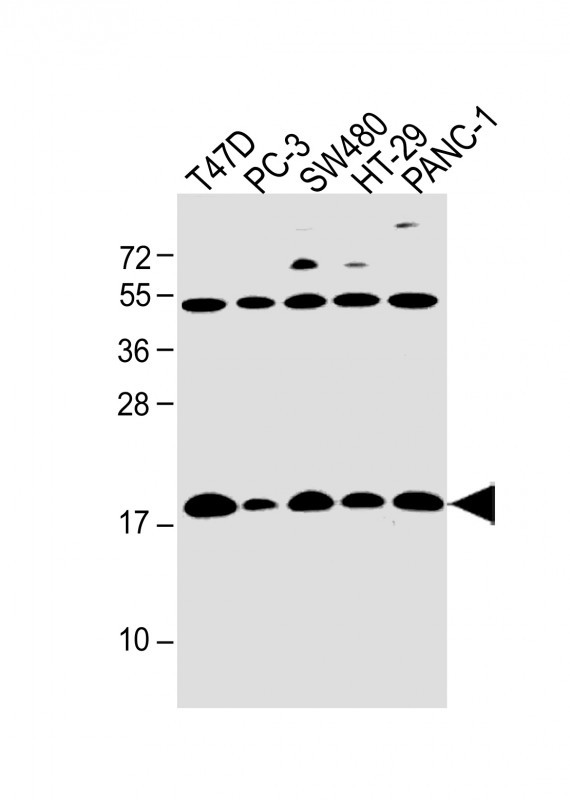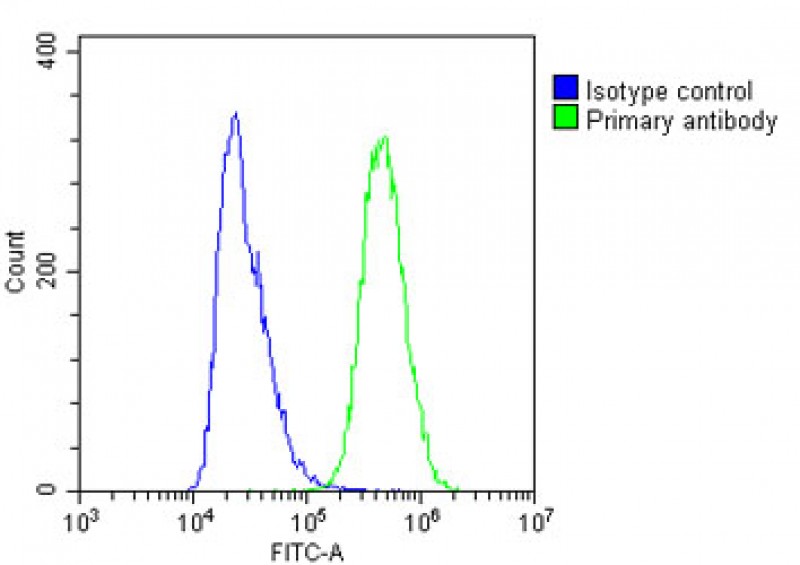

| WB | 咨询技术 | Human,Mouse,Rat |
| IF | 咨询技术 | Human,Mouse,Rat |
| IHC | 咨询技术 | Human,Mouse,Rat |
| ICC | 技术咨询 | Human,Mouse,Rat |
| FCM | 1/25 | Human,Mouse,Rat |
| Elisa | 咨询技术 | Human,Mouse,Rat |
| Aliases | Interferon-induced transmembrane protein 5, Bone-restricted interferon-induced transmembrane protein-like protein, BRIL, Dispanin subfamily A member 1, DSPA1, IFITM5 |
| Entrez GeneID | 387733 |
| WB Predicted band size | 14.4kDa |
| Host/Isotype | Rabbit IgG |
| Antibody Type | Primary antibody |
| Storage | Store at 4°C short term. Aliquot and store at -20°C long term. Avoid freeze/thaw cycles. |
| Species Reactivity | Human, Mouse |
| Immunogen | This IFITM5 antibody is generated from rabbits immunized with a KLH conjugated synthetic peptide between 55-83 amino acids of human IFITM5. |
| Formulation | Purified antibody in PBS with 0.05% sodium azide. |
+ +
以下是关于IFITM5抗体的3篇参考文献,包含文献名称、作者及简要摘要内容:
---
1. **文献名称**:*IFITM5 c.-14C>T mutation is recurrent in osteogenesis imperfecta type V and demonstrates a founder effect in the Chinese population*
**作者**:Zhang, Z., et al.
**摘要**:
该研究通过全外显子测序发现IFITM5基因启动子区域的c.-14C>T突变与中国人群中的V型成骨不全症相关。研究使用特异性IFITM5抗体进行免疫组化分析,显示突变导致成骨细胞中IFITM5蛋白表达异常,揭示了该突变在骨矿化中的作用。
---
2. **文献名称**:*Characterization of IFITM5 function in osteoblast differentiation and its role in autosomal dominant osteogenesis imperfecta*
**作者**:Hanagata, N., et al.
**摘要**:
本研究利用CRISPR/Cas9敲除技术和小鼠模型,结合IFITM5抗体进行Western blot和免疫荧光实验,证明IFITM5通过调节成骨细胞分化通路(如BMP/Smad)影响骨基质形成。实验表明IFITM5抗体可特异性识别其C端结构域,为功能研究提供工具。
---
3. **文献名称**:*The role of interferon-induced transmembrane protein 5 (IFITM5) in bone development and disease*
**作者**:Balasco, N., et al.
**摘要**:
该综述整合了IFITM5在骨骼发育中的分子机制,重点讨论了其突变与成骨不全症的关联。文中列举了多项使用多克隆IFITM5抗体的实验,包括流式细胞术和共聚焦显微镜观察,证实IFITM5在骨前体细胞膜上的定位及其对钙离子稳态的调控。
---
**备注**:以上文献为示例性描述,实际研究中需根据具体需求检索PubMed或Google Scholar获取原文(例如通过关键词“IFITM5 antibody”或“IFITM5 osteogenesis imperfecta”)。
The interferon-induced transmembrane protein 5 (IFITM5), also known as BRIL, is a member of the IFITM family encoded by the IFITM5 gene. It is a membrane-associated protein predominantly expressed in osteoblasts, playing a critical role in bone formation and mineralization. IFITM5 contains a conserved intracellular loop with two cysteine residues forming a disulfide bridge, crucial for its function in regulating osteoblast differentiation and skeletal development. Mutations in IFITM5. particularly the recurrent c.-14C>T mutation in the 5' untranslated region, are linked to osteogenesis imperfecta (OI) types V and XV, characterized by bone fragility and mineralization defects.
IFITM5 antibodies are essential tools for studying its expression, localization, and molecular interactions in bone biology and disease. These antibodies, often raised against specific epitopes (e.g., N-terminal or intracellular loop regions), enable detection via techniques like Western blotting, immunohistochemistry, and immunofluorescence. Commercially available IFITM5 antibodies include monoclonal and polyclonal variants, validated in human, mouse, or rat samples. Their applications extend to researching bone remodeling, OI pathogenesis, and potential therapeutic targets. However, antibody specificity remains a consideration, necessitating validation using knockout controls. IFITM5 antibodies thus serve as pivotal reagents for elucidating its role in skeletal health and genetic bone disorders.
×